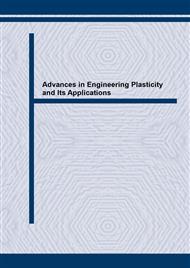[1]
J.D. Carlson, D.M. Catanzarite and K.A. St. Clair: Commercial magneto-rheological fluid devices, Proc. 5th Int. Conf. On ER Fluids, MR Fluids and Assoc. Tech., July 1995, W.A. Bullough, Ed., World Scientific, Singapore (1996) 20-28.
DOI: 10.1142/s0217979296001306
Google Scholar
[2]
J. Huang, J.Q. Zhang, Y. Yang, and Y.Q. Wei: Analysis and design of a cylindrical magneto-rheological fluid brake, Journal of Materials Processing Technology, 129(2002) 552-562.
DOI: 10.1016/s0924-0136(02)00634-9
Google Scholar
[3]
O. Ashour and A. Craig: Magneto-rheological fluids: materials, characterization, and devices, Journal of Intelligent Material Systems and Structure, 7(1996) 123-130.
Google Scholar
[4]
Pinkus, O and B. Sternlicht B: Theory of hydrodynamic lubrication (China Machine Press, China 1980).
Google Scholar
[1] [2] [3] [4] [5] [6] [7] 0 0. 05 0. 1 0. 15 0. 2 0. 25 Gap[mm] Velocity[m/s] B=0T B=0. 25T B=0. 35T Fig. 5 Velocity distributions at various magnetic field.
Google Scholar
[25] [50] [75] 100 125 150 175 0 0. 1 0. 2 0. 3 0. 4 Magnetic induction[T] Flow rate[cc/s] Fig. 6 Flow rate versus magnetic induction.
Google Scholar


